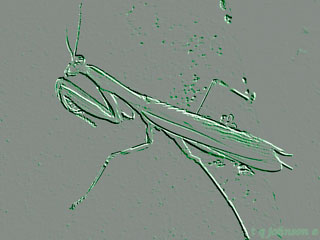Class: Insecta
Order: Mantodea
Family: Mantidae
The Garden Praying Mantis are carnivorous predacious insects in which the first pair of legs has developed completely for capturing prey. Below is a stylized gray scale relief of a “Dragon”; notice the elongated coxae (the first segment of the leg). In most insects, the coxae are quite small in comparison with the femur or tibia, not the case here just the opposite. Mantises have a highly developed sense of sight and can detect motion from a good distance away.
In addition, the head  of this insect can swivel around and “look backward over its shoulder”. With her keen eye fixed on a meal the male, much smaller, still has to be careful how he approaches to court her in the Mating Ritual or become Lunch in the process. Then at the end of summer in early Autumn She seeks dense cover under fallen tree branches or timber for protection to produce a three-growth stage, dual larvae nest made of a Natural Foam Material similar to the synthetic creation of Dow Chemicals, Polystyrene…material called Styrofoam.
of this insect can swivel around and “look backward over its shoulder”. With her keen eye fixed on a meal the male, much smaller, still has to be careful how he approaches to court her in the Mating Ritual or become Lunch in the process. Then at the end of summer in early Autumn She seeks dense cover under fallen tree branches or timber for protection to produce a three-growth stage, dual larvae nest made of a Natural Foam Material similar to the synthetic creation of Dow Chemicals, Polystyrene…material called Styrofoam.
Worldwide there is around 1800 species most of which occur in the tropics. The earliest  fossil Mantidae appear in the Cretaceous period roughly 130 million years ago. My Vote goes to the Mantis for the best of Bug Show in the Sex award category, meal et al. Even after their heads have been chewed off by their female partners, these various insects continue to have sex for up to eight hours.
fossil Mantidae appear in the Cretaceous period roughly 130 million years ago. My Vote goes to the Mantis for the best of Bug Show in the Sex award category, meal et al. Even after their heads have been chewed off by their female partners, these various insects continue to have sex for up to eight hours.

